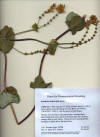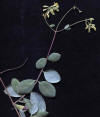|
Lonicera conjugalis |
Lonicera interrupta |
|
|
Lonicera
interrupta |
Lonicera
interrupta |
Lonicera involucrata
|
|
Lonicera involucrata
|
|
Lonicera
subspicata var. denudata |
|
Trees and Shrubs of Kern County (Dec 2012) Lonicera. Shrubs with twining stems, opposite leaves; flowers often in pairs and/or terminal scapes in umbel-like arrangements. often changing color after anthesis; pericarpia partially fused or distinct, surrounded by fruiting bracts in some species to form a compound glandoid dicarpium, or a simple glans. 200 spp, mostly in Asia, also North America south to Mexico, Mediterranean, temperate Europe, Himalayas, The Philippines, Malaysia; 10 spp. in California, 7 native, 3 in Kern Co..Many species cultivated as ornamentals, some of which are invasive; 8 spp. used medicinally by American tribes (Moerman). 100 extracts screened by the NCI before 1980, 3 active (L. involucrata pl from MT, aqueous P388; L. japonica stem from Korea, aqueous-ethanol SA, L. tatarica stem-leaf-fruit from IL, aqueous ethanol P388); 17 species collected from the US for the NCI since 2000. Key to Lonicera 1.Upper leaves fused around stem ...... 2. Flowers purplish, or pink to rose........................................ Lonicera hispidula ...... 2. Flowers yellow, cream, or white....................................... Lonicera interrupta 1. Upper leaves separate from each other.................................... Lonicera subspicata ...... Lonicera hispidula Douglas ex Torrey & A. Gray 1841. (Includes var. vacillans A. Gray 1873). Pink honeysuckle. Climbing shrub with branches to 6 m long; stems purplish-glaucous; leaves heart-shaped to triangular, or elliptical, rounded to apex, uppermost fused around stem, 1–2× longer than wide, 3.5–8 cm. Flowering Apr–Jul; flowers in terminal clusters on short simple to branched scape-like stems, purplish to pink, funnelform, the lobes recurved to apex, 12–18 mm. Fruit an aggregate of partially fused baccate pericarpia, or collectively a sorosus. British Columbia to southern California, mostly along streams in canyons below 2,500 ft in the Coast Ranges, rare in the Sierra Nevada. Type from “woods of Northwest America.” Kern Co.: Tehachapi Mountains (CCH: H. Bauer, Oct 1928). Lonicera interrupta Bentham 1849. Chaparral honeysuckle. Evergreen climbing shrub, the main stem woody, erect to 30 cm, much-branched above with purplish-glaucous stems; leaves limp or flaccid, broad elliptical, rounded to apex, uppermost fused around stem, 1–1.5× longer than wide, 1.5–3.5 cm, green above with or without hairs, glaucous below, uppermost fused around stem; flowering May–Jul; flowers in terminal interrupted whorls on long simple to few branched leafless flowering shoots 3-16 cm, pale yellow to cream, occasional with tinge of rose, tubular, curved, and with an expanded sac-like bulge on the lower side, the lobes recurved to apex, 10–14 mm. Fruit mostly of distinct berries. Dry chaparral woodland and pine forests, 1,000–6,000 ft, mostly Klamath Mts, Inner Coast Ranges, western Sierra Nevada, Transverse Ranges, Peninsular Ranges, southeastern Arizona. Type from near Carmel River, Monterey, CA. Kern Co.: “Occasional from the Douglas oak woodland to the yellow pine forest in the Greenhorn Range, on Breckenridge Mountain, and in the Piute Mountains; rare, south to Tweedy Canyon east of Keene,” “often severely browsed by deer” (Twisselmann), 762–1,523 m (CCH). Mendocino and Yuki native American tribes applied leaves in an wash infusion for sore eyes, Shoshoni applied root as a poultice for swellings (Moerman). Lonicera subspicata Hooker and Arnott 1839 var. denudata Rehder 1903 [Includes var. johnstonii D. D. Keck 1926; L. johnstonii (D. D. Keck) McMinn 1939]. Southern honeysuckle. Evergreen climbing shrub to nearly 3 m, the main stem arising from a burl-like root, woody near base, with peeling bark; secondary stems numerous, leafy, reddish-purple; leaves rigid, broad elliptical to wider above mid region, rounded to apex, uppermost not fused around stem, 1–1.5× longer than wide, 0.5–2.0 cm, dark green above with sessile gland, with short white hairs below, uppermost not fused around stem; flowering Jun–Aug; flowers in terminal interrupted whorls on simple to few branched leafless flowering shoots 2-4 cm, pale yellow to white, tubular, curved, the lobes recurved, 8–10 mm. Fruit mostly of distinct berries, yellowish orange to red. Inner Coast Ranges from Mt. Diablo south to Sierra Juárez in Baja California. Type from Santa Barbara, CA . Kern Co.: “Occasional in the chaparral and the Douglas oak woodland from the Temblor Range southeast through the San Emigdio Range to Ft. Tejon” (Twisselmann), 761–1,757 m (CCH). Plant decoction used to wash sores on horses (Moerman).
|
||








